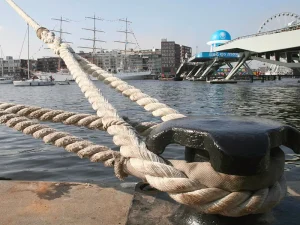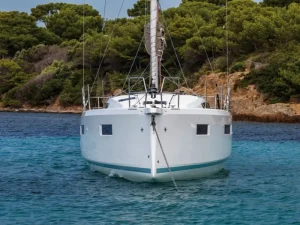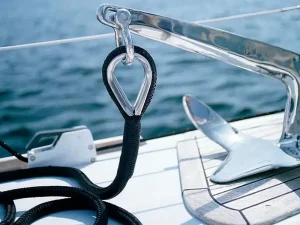O tamanho correto do cabo da âncora garante a permanência tranquila de barcos e embarcações. Esse tamanho varia de acordo com as condições da água, das marés e do clima. Portanto, você terá de calcular o tamanho correto do cabo de ancoragem sempre que quiser ancorar o barco. Entretanto, essa calculadora é muito complicada e pode facilmente confundir muitas pessoas. Surge uma pergunta: qual deve ser o comprimento de seu cabo de ancoragem?
A resposta a essa pergunta depende do clima e da profundidade da água. Quando você conhece esses dois parâmetros, fica fácil calcular o tamanho certo. Há uma fórmula simples e um cálculo matemático para encontrar o tamanho do cabo da âncora. Neste artigo, tornarei esses cálculos muito fáceis. Da próxima vez, você não precisará perguntar a outras pessoas sobre o tamanho do cabo da âncora.
O que é um Anchor Line?

Para os iniciantes, vamos começar pelo básico. A âncora é uma parte metálica de um dispositivo que mantém embarcações ou barcos em um ponto. Essa âncora entra no corpo d'água e se prende ao fundo do mar. Mas como a âncora mantém o navio em uma posição estável? É por causa do cabo da âncora.
O cabo de ancoragem ou cabo de aço conecta o barco e a âncora. Ele pode ser feito de corrente ou corda. No entanto, é sempre muito forte, pois segura ou mantém o barco em uma posição estável. A âncora toca o fundo do mar e o cabo da âncora conecta essa âncora ao barco. Como as âncoras permanecem embutidas no fundo do mar, o barco permanece imóvel e não fica à deriva.
Você entendeu os conceitos básicos do cabo de ancoragem e sua função? Vamos discutir por que o tamanho certo é importante em relação ao cabo de ancoragem. Suponha que você tenha um barco e o ancore com um cabo de ancoragem menor. O barco não ficará estável e a âncora sofrerá mais tensão. Além disso, a própria linha sofrerá mais estresse.
Por outro lado, imagine um caso em que você ancora um barco com um cabo de ancoragem longo. Nesse caso, a linha criará mais folga. O barco enfrentará mais instabilidade, especialmente em tempo de vento. Além disso, o barco pode se afastar e colidir com objetos ou embarcações próximas. O tamanho correto da linha de ancoragem garante que o barco fique estável mesmo com mau tempo.
Como calcular a linha de ancoragem?

Você tem controle sobre um cabo de ancoragem e por que o tamanho dele é importante? Vamos prosseguir com o cálculo do tamanho correto. Lembre-se, o cálculo da linha de ancoragem envolve uma fórmula que é a seguinte:
Comprimento do cabo da âncora = Escopo × (profundidade da água + altura da proa)
Vamos seguir etapas simples para garantir que você não se confunda:
- Primeiro, calcule a profundidade da água onde você deseja ancorar seu barco ou embarcação.
- Em segundo lugar, meça a distância entre o nível da água e a proa. A proa é um ponto de fixação onde a linha da âncora é presa ao barco.
- Quando você tiver essas duas medidas, some-as e calcule a soma.
- Multiplique a soma da profundidade da água e da altura da proa pelo número do escopo.
Mas a questão é: qual é o escopo? Isso cria uma confusão real, pois muitos não entendem o escopo.
O escopo é a relação entre o tamanho da linha de ancoragem e a profundidade da água. Simplesmente, ele indica o tamanho da linha de ancoragem para um nível específico de profundidade da água. Você pode saber o número do escopo quando souber a profundidade. O escopo varia de acordo com as condições climáticas. Em clima calmo, o escopo será baixo e vice-versa.
Como eu disse, o alcance depende das condições climáticas. Aqui está o valor do alcance para diferentes condições climáticas:
- Tempo calmo: Escopo 3:1
- Clima moderado: Escopo 5:1.
- Clima adverso: Escopo 7:1.
- Clima extremo: Escopo 9:1 ou 10:1
Use a linha de ancoragem de 3 pés para um pé de profundidade de água se o tempo estiver calmo. Da mesma forma, se o tempo estiver moderado, use 5 pés de linha de ancoragem para um pé de profundidade de água. O tamanho da linha de ancoragem aumenta para um pé de profundidade de água em condições climáticas adversas. Agora, você pode colocar esses valores na fórmula fornecida acima e calcular o tamanho exato do cabo de ancoragem.
Qual deve ser o comprimento de sua linha de ancoragem?

Mencionei todas as informações acima para que você esteja preparado para entender a resposta. Saber o comprimento de sua linha de ancoragem depende de alguns fatores. Esses fatores incluem:
- Profundidade da água
- Altura da proa em relação à água
- O escopo depende do clima.
O comprimento da âncora nunca é fixo e muda de acordo com os parâmetros mencionados acima. Suponha que você esteja em um clima calmo. A profundidade da água é de 5 pés e a altura da proa é de 2 pés. Vamos calcular o comprimento colocando esses parâmetros na fórmula:
Comprimento da linha da âncora = 3 × (5 + 2) = 21 pés.
Supondo que seu barco estivesse em clima calmo, usei três como escopo. Você pode usar 5 para condições climáticas moderadas e 7 para condições climáticas adversas. Se o tempo estiver ruim, não há problema em usar 8 ou 9 como escopo.
Vamos supor outro cenário. Seu barco está em uma profundidade de água de 10 pés e o tempo está moderado. Além disso, a altura da proa é de 3 pés. Nesses casos:
Comprimento do cabo da âncora = 5 × (10 + 3) = 65 pés.
Basta inserir os valores para descobrir o comprimento que sua linha de ancoragem deve ter. Lembre-se de que não há uma resposta única com relação ao comprimento da linha de ancoragem. Ele varia de acordo com o clima, as marés, a profundidade da água, etc.
Posso usar o escopo superior ou ele é fixo?
Sim, você pode usar um escopo maior em vez de se limitar ao máximo de 7:1. Não existe uma regra rígida e rápida sobre o escopo que você deve usar. Ele não é fixo; varia de acordo com o clima e as condições do corpo d'água. Em condições climáticas piores, você pode usar um escopo maior de 9:1 ou até 11:1.
Suponha que você esteja em um corpo d'água cuja superfície seja lamacenta e o tempo esteja ruim. Em tais condições, você deve usar um escopo maior que 7:1. Essa proporção nunca é fixa e permite que você a ajuste de acordo com as condições. O espaço de ancoragem que você obtém em qualquer posição específica também define seu alcance.
Por exemplo, você está ancorando em uma posição onde outros barcos já estão ancorados. Nesse caso, você terá menos espaço se o seu barco se deslocar e colidir com outros. Nesses casos, você deve usar menos escopo. Isso manterá o barco em uma área específica e evitará que ele se desvie. Em resumo, você deve considerar o escopo como uma diretriz, não como uma regra fixa.
O tipo de âncora influencia o comprimento do cabo da âncora?
A resposta é SIM!
Existem diferentes tipos de âncoras usadas no mundo marinho. Algumas âncoras, como a Danforth, precisam de uma penetração profunda no leito marinho. Essas âncoras são muito leves e, sem uma penetração profunda, não podem funcionar com eficácia. Por outro lado, algumas âncoras não precisam de penetração profunda.
Elas são pesadas e sua leve penetração no fundo do mar é mais do que suficiente. Uma âncora leve que exige penetração profunda requer um cabo de ancoragem mais longo. Por outro lado, as âncoras pesadas exigem linhas de ancoragem um pouco menores, pois não precisam penetrar profundamente. Você deve conhecer o tipo de âncora antes de selecionar o tamanho da linha de ancoragem.
Destaque rápido: O tipo de âncora que você tem não afeta significativamente o comprimento da linha de ancoragem. Por esse motivo, as pessoas não levam em conta o tipo de âncora ao selecionar o comprimento da âncora. Em vez disso, elas usam regras gerais dependendo das condições climáticas. No entanto, se você quiser ser mais cuidadoso, use uma linha de ancoragem um pouco maior para uma âncora leve e vice-versa.
Existe uma regra padrão para o comprimento do cabo de ancoragem em todos os barcos?
A resposta é NÃO!
O comprimento do cabo de ancoragem varia de acordo com muitos fatores, incluindo profundidade, altura da proa e condições climáticas. Qualquer flutuação em qualquer fator nos obriga a usar menos ou mais cabos de ancoragem. Em algumas condições, você precisará apenas de um cabo de ancoragem com três vezes a profundidade da água.
No entanto, se o tempo estiver ruim, você pode precisar de um comprimento de linha de ancoragem de 7 ou 10 vezes a profundidade da água. Entretanto, as pessoas geralmente usam 7 vezes mais linhas de ancoragem do que a profundidade da água. Novamente, esse é o uso padrão, mas não uma regra. Para saber o comprimento correto do cabo de ancoragem, você deve fazer o cálculo.
Barco x embarcações: O que requer mais comprimento do cabo de ancoragem?
Os navios exigem linhas de ancoragem longas devido ao seu tamanho e peso maiores. Além disso, eles carregam mais cargas. Portanto, o vento, a maré e o clima podem fazer com que eles se afastem. O longo cabo de âncora mantém a embarcação sob controle. Os barcos são leves e não requerem grande força de sustentação. Portanto, o cabo de âncora menor funciona bem para barcos e outras embarcações pequenas.
Além disso, as embarcações geralmente param em níveis de água muito profundos, certo? Suas âncoras geralmente são mais longas devido à maior profundidade da água. Por outro lado, os barcos permanecem em águas menos rasas, portanto, seus cabos de ancoragem também são menores. Lembre-se de que as linhas de ancoragem têm marcações que indicam quanto tempo estão dentro da água.
Perguntas frequentes
Qual é o melhor comprimento para uma corrente de âncora?
Geralmente, o comprimento 7:1 é considerado o melhor para a corrente da âncora. Entretanto, se o tempo estiver calmo, você deve usar 5:1 ou 3:1 para melhor manuseio.
Como você calcula o tamanho da âncora?
O tamanho da linha de ancoragem pode ser calculado usando a seguinte fórmula:
Comprimento do cabo da âncora = Escopo × (profundidade da água + altura da proa)
Você deve saber a relação de alcance, a profundidade da água e a altura da proa. Insira os valores desses parâmetros na fórmula acima para obter o tamanho exato de seu barco.
Qual é o comprimento do cabo de ancoragem necessário?
Não há uma resposta exata, pois isso depende do clima, da profundidade da água e da altura da proa. No entanto, usar uma proporção de 7:1 proporciona um desempenho decente. Isso significa que você deve ter 7 pés de linha de ancoragem para cada 1 pé de profundidade da água. Se a água tiver 1,5 metro de profundidade, use linhas de 35 pés de comprimento.
Conclusão
O comprimento correto da linha de ancoragem faz toda a diferença. No entanto, a maioria das pessoas não sabe como ele é calculado. Lembre-se de que usar o tamanho errado do cabo de ancoragem pode afetar sua experiência de ancoragem. Seu navio ou barco pode ficar à deriva ou permanecer instável. A seleção de âncoras torna-se mais essencial em condições climáticas ruins. Neste artigo, expliquei o procedimento de cálculo do comprimento do cabo da âncora.
